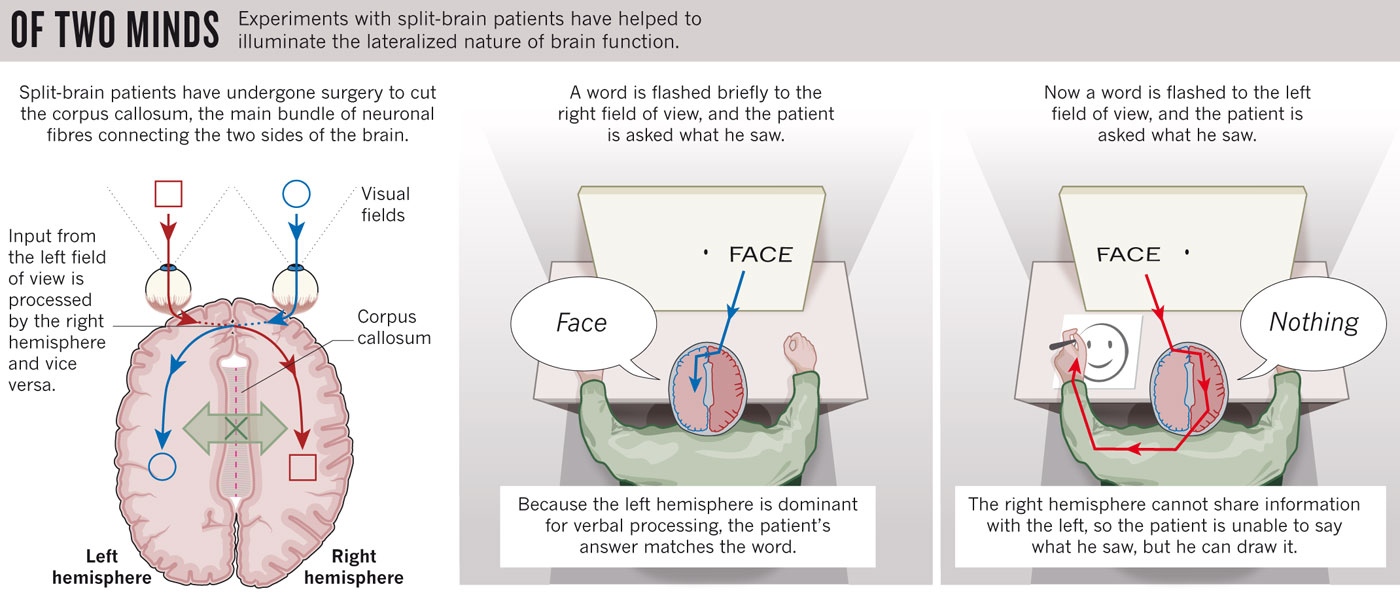"Well I'm very intuitive and good at art because my right hemisphere is dominant".
"I'm left-hemisphere dominant so I'm better with numbers and more logical".
We associate various skills with a certain hemisphere of the brain and say that we are "dominant" in the hemisphere that corresponds with our abilities. Our ability was predetermined at birth through the way our brain is structured.

Intuitively they make sense; we can think of people who are better at maths or science and are weaker in the arts and vice versa. It also intuitively makes sense that these general abilities would be located in different parts of the brain (we know that specific abilities are processed by certain parts of the brain). Unfortunately though, this idea of a "left-brain right-brain" divide is scientific nonsense.
A bit of history: this myth arose out of genuine science. It was discovered that damage to one side of the brain resulted in a loss of specific abilities e.g. damage to the right side of the brain usually resulted in an impairment in a person's spatial abilities and damage to the left would result in a decrease in the patient's language ability. It was also discovered that the left-hemisphere of the brain controlled the right-hand side of the body and processed information from that side and vice versa. The idea of "left-brain right-brain" gained further traction in the 1960's when patients with severe epilepsy were examined. In order to cure their epilepsy, they had their corpus callosum (the neural pathway between the two hemispheres) severed. This stops the patients epilepsy, but results in their hemispheres being unable to communicate. An experiment by Gazzaniga, Bogen & Sperry (1962) on the patient W.J. illustrates this nicely: W.J. was shown a screen and told to say whatever word was flashed onto the screen. When the word appeared on the right hand side of the screen, he could say what he saw. This is because the left hemisphere is more dominant for verbal processing (and remember the left side of the brain processes information from the right field of view). However, when the word appeared on the left-hand side, he said he couldn't see anything. But he could draw whatever the word described. This is because the right-hemisphere is dominant for processing images.

Because of these facts, some people believe that one of their hemispheres can be dominant and therefore they are better at those abilities associated with that hemisphere. But the biggest problem with this idea is that specific skills aren't localised entirely within one hemisphere. For example, language is now understood to take place in both hemispheres: the left side processes grammar and pronunciation whilst the right processes intonation and emphasis. Both of these skills are essential for processing language, so to say language is localised within one hemisphere is just incorrect. Similarly, experiments have shown that the right hemisphere does not work in isolation with regard to spatial ability; the right hemisphere deals with a general sense of space while the left processes objects in specific locations.
Another problem is with the categories that are supposed to be dealt with by the different hemispheres e.g. creativity (in the right hemisphere). There are many different ways of being creative and these different processes have been mapped to different sides of the brain. For example, the right side of the brain is more involved in processes that involve insight (which in this scenario means creatively thinking about a problem to gain sudden realisation of the answer) but the left side is more involved with creating stories (Jung-Beerman et al., 2004). Both of these are types of creativity, yet are located in different hemispheres of the brain. To put the final nail in this myths coffin, a study by Nielsen et al (2013) study analysed thousands of brains and found that people do not have a "dominant" hemisphere.
The 'left-brain right-brain' myth will probably never go away unfortunately as it's an easy way to explain differences between people. It also provides "scientific" support for what people already believe in: "I'm good at art and rubbish at maths because I'm right-brain dominant" (this is the idea of confirmation bias, which I will cover in a later blog).
References:
BrainHQ. (2014). Brain Mythology. Available: http://www.brainhq.com/brain-resources/brain-facts-myths/brain-mythology. Last accessed 08/01/2014.
Gazzaniga, M.S.; Bogen, J.E.; & Sperry, R.W. (1962). Some functional effects of sectioning the cerebral commissures in man. Proceedings of the National Academy of Sciences of the United States of America, 48 (10), 1765-1769.
Jarrett, C. (2012). Why the Left-Brain Right-Brain Myth Will Probably Never Die. Available: https://www.psychologytoday.com/blog/brain-myths/201206/why-the-left-brain-right-brain-myth-will-probably-never-die. Last accessed 08/01/2014.
Jung-Beerman, M.; Bowden, E.M.; Haberman, J.; Frymiare, J.L.; Arambel-Liu, S.; Greenblatt, R.; Reber, P.J.; & Kounios, J. (2004). Neural Activity When People Solve Verbal Problems With Insight.PLoS Biol, 2 (4), e97. doi:10.1371.journal.pbio0020097.
Martinez, M.E. (2013). Everything you know about the brain is wrong. Available: http://www.salon.com/2013/07/21/everything_you_know_about_the_brain_is_wrong/. Last accessed 08/01/2014.
Nielsen, J.A.; Zielinski, B.A.; Ferguson, M.A.; Lainhart, J.E.; & Anderson, J.S. (2013). An Evaluation of the Left-Brain vs. Right-Brain Hypothesis Resting State Functional Connectivity Magnetic Resonance Imaging. PLoS One, 8 (8): e71275. doi:10.1371/journal.pone.0071275
No comments:
Post a Comment